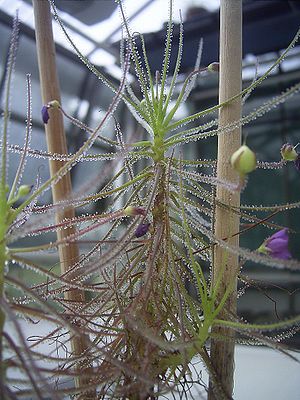Byblis aquatica
| Byblis aquatica | ||||||||||||
|---|---|---|---|---|---|---|---|---|---|---|---|---|

Byblis aquatica |
||||||||||||
| Systematics | ||||||||||||
|
||||||||||||
| Scientific name | ||||||||||||
| Byblis aquatica | ||||||||||||
| Lowrie & Conran |
Byblis aquatica is a carnivorous plant species of the genus byblis in the family of byblis plants (Byblidaceae). It was described in 1998 by the botanists Allen Lowrie and John Godfrey Conran and is one of the annual, northern Australian Byblis species, which are collectively referred to as the " Byblis liniflora complex".
features
Byblis aquatica is an annual, mostly unbranched plant species, its roots are fine-grained. It reaches a height of up to 45 centimeters, young, smaller plants up to about 5 cm stand upright, medium-old plants up to about 15 centimeters in length lean against neighboring plants, larger ones lie on the ground or float in water, with the upper part of the plant always grows upright.
leaves
The leaves are two to four inches long, oblong and round and taper towards the end. Young leaves are almost upright, light green, but quickly turn dark purple to brownish red. With age, the leaves droop and begin to wither. From the beginning to the end they are covered all around with stalked glands that secrete a sticky liquid. In addition to catching insects, they also serve to adhere to neighboring plants and thus keep the plant upright.
blossoms
From some leaf axils , flower stalks grow above the base of the leaves , which hardly differ from the leaves, but are slightly shorter at 1.5 to 3 centimeters. At their tips between January and May (in the Australian summer) terminal five-fold individual flowers bloom, but only a few at the same time.
The egg-shaped, almost hairless sepals are 3 to 4 millimeters long. The inverted egg-shaped petals are deep purple, 5 to 7 millimeters long and up to 4.5 millimeters wide and notched on the outer edge. The stamens are 2 to 2.5 millimeters, the yellow anthers 0.9 to 1.3 millimeters long. The stylus is 2 to 2.5 millimeters long, the scar is papillary .
Fruits and seeds
The 3 to 4 millimeter long and 2.5 to 4 millimeter wide seed capsule is broadly egg-shaped and two-faced; when it dries out, it gradually tears open, so that the seeds it contains fall to the ground or into the water ( barochory or hydrochory ). The black, 1 to 1.3 millimeter long seeds are furrowed lengthways.
Chromosome number
The number of chromosomes is 2n = 16.
distribution
The species has a very small range in the Australian Northern Territory , it is endemic between Darwin and Berry Springs , but is common there. It grows in loamy sand on seasonally flooded depressions and on the shallow shores of freshwater lagoons and is often associated with Byblis liniflora , which, however, is always somewhat distant from the semi- aquatic locations of Byblis aquatica .
Botanical history
Byblis aquatica was first collected by Allen Lowrie on the Howard River in April 1988. In cultures of carnivore lovers it was called Byblis aff. liniflora "Darwin" and classified as an ecotype . Only after Barry Meyers-Rice provided evidence of the reproductive isolation of the species, Jan Flísek proposed the description as a separate species in 1996, which Allen Lowrie then wrote as part of his revision of the North Australian species in 1998.
swell
- Allen Lowrie , John G. Conran: A Taxonomic Revision Of The Genus Byblis (Byblidaceae) In Northern Australia. In: Nuytsia . Vol. 12, No. 1, 1998, pp. 59-74, ( digital version (PDF; 1.1 MB) ).
- John G. Conran, Allen Lowrie: Byblis liniflora subsp. occidentalis (Byblidaceae). A New Subspecies From North-Western Australia. In: Australian Systematic Botany. Vol. 6, No. 2, 1993, ISSN 1030-1887 , pp. 175-179, doi : 10.1071 / SB9930175 .
further reading
- Barry Meyers-Rice: Byblis - Notes On Forms New To Cultivation. In: Carnivorous Plant Newsletter. Vol. 22, No. 1/2, 1993, ISSN 0190-9215 , pp. 39-40, ( digital version (PDF; 357.4 kB) ).
- Jan Flísek: Byblis aff. liniflora Darwin - Novy druh rodu Byblis? In: Trifid. Časopis společnosti Darwiniana. Vol. 1, No. 4, 1996, ISSN 1214-4134 , pp. 27-28, 43.
Individual evidence
- ^ Byblis aquatica at Tropicos.org. In: IPCN Chromosome Reports . Missouri Botanical Garden, St. Louis

